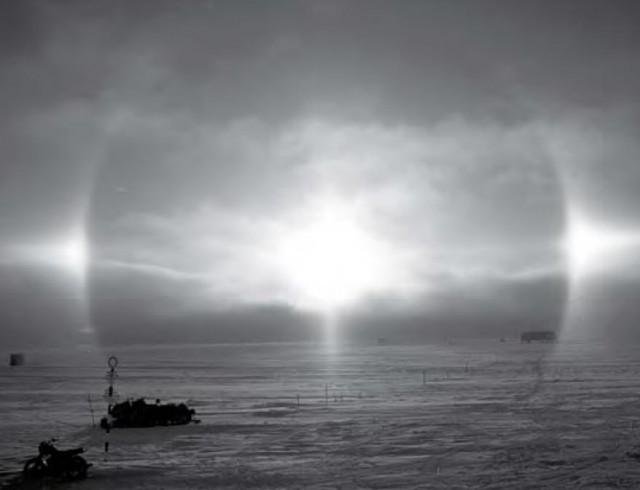Atmospheric special effects
Even with no clouds in the sky, there are plenty of amazing atmospheric phenomena to look at. Many, it turns out, are to do with ice.
The most basic is a ring of light seen around the Sun or Moon when conditions are cold enough for there to be ice crystals at altitude. It is far simpler to spot at night surrounding the Moon, because it is then against a dark sky, but with care it can also be seen around the Sun on a winter's day. It appears because light is refracted through the crystals and back to the observer. Because ice refracts light by 22°, the ring of light, called a halo, is always 22° from the Moon or Sun.
Most of the ice found in the upper atmosphere is in the form of hexagonal needle-shaped crystals. But some appears as flat, hexagonal crystals. When light passes through these near the horizon, a paler but still very visible copy of the Sun or Moon, called a Sundog or Moondog, will appear. (A Sundog is more
formally a parhelion.) With luck you might also see a tangent arc touching the halo, caused by ice needles aligned horizontally. Rarest of all is a circumzenith arc, a kind of part-rainbow around the sky's zenith when the Sun is about 22° above the horizon.
However, water does not have to be in solid form to produce extraordinary sky effects. Take the glory. This is a ring-shaped rainbow which can appear opposite the Sun in the sky as light is scattered back from droplets of water in the atmosphere. It is seen in its most terrifying form in the Brocken spectre – a ghostly production in which you are bound to be the star. Any time you are walking in mountains, you may see your shadow reflected on cloud or mist below. But if a glory surrounds it, the effect is especially eerie. Certainly it used to spook people on the Brocken, one of the Harz mountains in Germany, who gave it the name.
Of course, the granddaddy of all these phenomena is the rainbow itself. Here the principle is one we learnt at an early age. If there are rain and sunshine at the same time, conditions are ripe for a rainbow, or more than one.
A rainbow is created when there are raindrops in the sky, and sunlight for them to reflect and refract back towards the viewer. This makes a bright disc of light in the sky opposite the Sun, but this can be hard to see. The brightest part is the bow at its edge, which shows the colours of the spectrum because light of varying wavelengths is refracted at slightly different angles by water. Blue light is sent back to you at an angle of 40° from the direction the sunlight arrived at, and red light 42°, so the rainbow is 2° wide in the sky, about four times the width of the full Moon. Light in this brightest bow has been refracted as it entered the water drop, reflected off the back of the drop, and refracted again as it left the drop.
Outside this primary bow is a dark area of sky, a zone from which no light can reach the observer. This is Alexander's Dark Zone, recorded by Alexander of Aphrodisias in 200 AD. Beyond it there is often a secondary rainbow caused by light reflected twice inside the raindrops. It is a mirror of the first, with the red edge at the inner side and so facing that on the outside of the brighter first bow. In ideal conditions, even-higher-order, fainter bows can be seen.
For more information and images, see: Atmospheric Optics www.atoptics.co.uk
